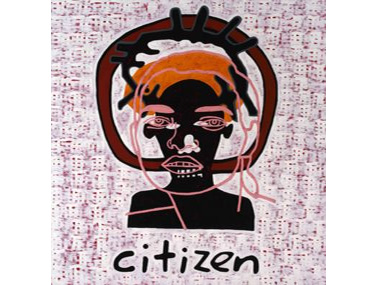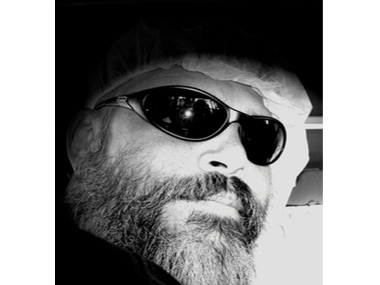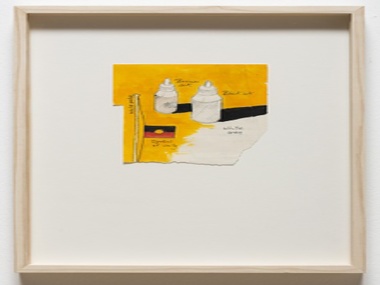GORDON BENNETT 1955 to 3 June 2014

'Abstraction (Citizen)' 2010, A late Gordon Bennett work on canvas appropriating both Basquiat and Kngwarreye
Jeremy Eccles | 28.06.14
Author: Jeremy Eccles
News source: Research
“I am an Indigenous Australian. My mother is an Indigenous Australian and her mother before that and so on for countless generations. My father was English. My work comes out of small town and suburban Australia. I was socialised into an essentially Anglo-Saxon society where attitudes to Indigenous people still seemed entrenched to a Social Darwinist level. From cocktail parties to work place parties, predominantly derogatory opinions are exchanged about Indigenous people with unquestioning ease and assurance”.
Thus wrote the late Gordon Bennett in 1992 in the catalogue in which his art was included in a Government-sponsored exhibition in Korea.
Several significant strands of thought can be drawn from this statement. The first is obviously the broad-mindedness of the Department of Foreign Affairs in selecting this angry young artist to represent Australia. But of greater moment is the fact that Bennett had completed his art training at the Queensland College of Art in 1988, just four years previously. While he may have started his art practice relatively late in life after work as a Telstra linesman, the searing experience of discovering his Aboriginal identity only in his mid-teens – it was hidden from him lest he be 'taken away' – had given him sufficient time to know with clarity that “My identity was shaped by the historical narratives of colonialism with all its romantic illusions and factual deletions”.
And his art would dwell on that for the next 25 years with wit, intellectual rigour and a visual acuity that allowed him to seize on familiar imagery from van Gogh and Mondrian, Imants Tillers and Margaret Preston, Ai Weiwei and, above all, the African-American John-Michel Basquiat, and re-order it to his own satisfaction – and that of the market. He even borrowed dotting from Desert artists such as Emily Kngwarreye. “I appropriate and re-contextualise found images that have accumulated certain historical meaning over time”, was how he put it in 1992.
In 1998, Bennett wrote a letter to the already-dead Basquiat when he was invited to show at the Contemporary Art Fair in New York, the American's home city, explaining his appropriation of the his trademark rap aesthetic on the grounds that they shared a fluidity of identity. He was a white boy who'd suddenly become black. For, by 1998, Bennett felt he had been “crowned in Australia as an 'Urban Aboriginal' artist – underscored as that title is by racism and 'primitivism' – and I do not wear it well”. And he concluded this posthumous letter: “To be a race-identified race-refugee is to tap-dance on a tightrope. You lost your balance (dying of a heroine overdose), I feel I can understand why. I salute you”.
Bennett never allowed his Brisbane dealer, Josh Milani to sell his works to the Indigenous sections of state galleries or to specialist Aboriginal art dealers. Unlike other artists who rejected the 'urban Aboriginal' label, such as Richard Bell, he never entered the Aboriginal & Torres Strait Islander Art Awards.
Gordon Bennett was born in Monto, Central Queensland on 9 October 1955 to Grace (nee Bradley) and Don Bennett and grew up in rural Victoria and Queensland. The family travelled widely with Don’s work, finally settling in Nambour, where Gordon attended Nambour State High School around the same time as Wayne Swan and Kevin Rudd. He was a self-confessed ‘average student’, yet excelled in art, social studies and English, subjects that would be central to his future career.
Rudd would later open a 2003 exhibition of Bennett's paintings critical of Australian involvement in the Iraq War, an apparent internationalising of his subject-matter, as the Sherman Gallery catalogue author Ian Mclean explained – for Bennett himself rarely spoke about his own work: “Recently, Australians re-elected a government campaigning with the familiar xenophobic rhetoric of the white Australia of old – (so) maybe events in far away places might shake this national amnesia”.
Later, in the 2008 Sydney Biennale, Bennett would seek to shake up the august Art Gallery of NSW by swapping the Aboriginal art in the basement Yiribana Gallery for the colonial art above. All the relocated art would hang upside down – which would have made little difference to the Gallery's tribal paintings, invariably painted flat on the ground to be viewed from all directions. The AGNSW rejected the idea out of hand.
But it was a sufficiently revolutionary project for Biennale curator Carolyn Christov-Bakargiev to recruit Bennett for her prestigious 2012 Documenta exhibition in Germany, which lead on to his selection for the current Berlin Biennale. The Berlin works are a series of thirty 'naïve' Notepad Drawings from the early 1990s, never shown previously. “If they resemble naive art aesthetically”, explained his dealer Milani, “it's because they are very raw - they were done with an urgency, an immediacy, like an emotional purge. In 2012, we had a conversation about how Australia was becoming more politically conservative; he couldn't believe Tony Abbott was even a contender for PM. He made a joke that he'd done a painting of Tony Abbott before he'd even heard of him. He was referring to the fellow in an image talking to his erection and saying: 'fuckin boongs get too much'. I thought this was very funny and showed the series to the curator of the Berlin Biennale, Juan Gaitan,who exclaimed: ''I must have them for my show'! It suited his idea that artists can embody political tensions through their biography or heritage”.
Milani continued, “His sudden death (from natural causes) comes at a time when his work was finding new audiences internationally”. Bennett certainly lived to justify the precocious promise of his Moet et Chandon Fellowship in 1990, an artwork on the cover of Bernard Smith's 'Australian Painting' in 1991, selection for the Havana Biennial and a group show at the Guggenheim in NY in 1994, and a European tour for the 1999 Queensland Art Gallery exhibition, 'History and Meaning in the Art of Gordon Bennett'.
Subsequent solo retrospectives have been held at the National Gallery of Victoria in 2007 and, somewhat ironically, at the Museum of Contemporary Aboriginal Art in Utrecht in 2012.
Josh Milani concluded his assessment: “Gordon really was the first artist to explore our Indigenous past using conceptual art techniques. To that extent he really kicked the door open for artists who followed in similar territory, such as Brook Andrew, Vernon Ah Kee, Tony Albert, Danie Mellor etc.”.
In 1977 Bennett married Leanne, who was a tower of strength throughout his life and art. And in 1993 they had a daughter Caitlin, whom Gordon cherished to the very end.
URL: Milani Gallery
Share this:
»  del.icio.us
»
del.icio.us
»  Digg it
»
Digg it
»  reddit
»
reddit
»  Google
»
Google
»  StumbleUpon
»
StumbleUpon
»  Technorati
»
Technorati
»  Facebook
Facebook
Contact Details

The late Gordon Bennett.

Detail from an installation by Gordon Bennett currently showing at the Berlin Biennale
Further Research
Artists: Emily Kngwarreye | Gordon Bennett
News Tags: Berlin Biennale | Gordon Bennett | Jean-Michel Basquiat | Jeremy Eccles | Milani Gallery
News Archive
- 11.10.17 | RETURN OF MUNGO MAN
- 10.10.17 | TARNANTHI 2017
- 11.08.17 | Natsiaas 2017
- 08.08.17 | ABORIGINAL ART ECONOMICS
- 02.08.17 | SCHOLL'S NEXT MOVE
- 20.07.17 | APY ART DOMINATES THE WYNNE
- 17.07.17 | Anangu Artist Wins $100,000 Prize
- 14.07.17 | The End of AAMU
- 13.07.17 | YOU ARE HERE
- 11.07.17 | ART ACROSS THE COUNTRY
- 11.07.17 | TARNANTHI IN OCTOBER
- 05.07.17 | TJUNGUṈUTJA - from having come together
- 02.07.17 | BENNELONG
- 27.06.17 | JIMMY CHI
- 23.06.17 | Blak Markets at Barangaroo
Advertising

